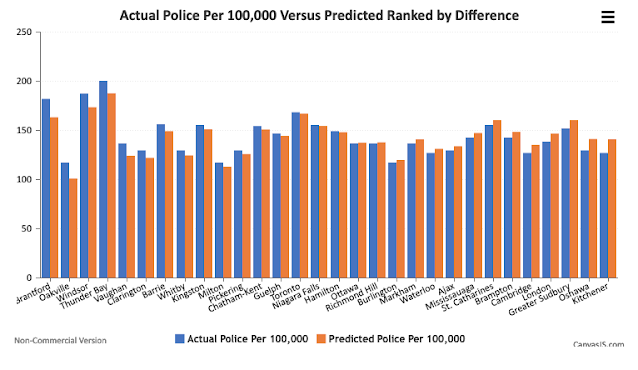It appears that police month is continuing here on Northern Economist as I came across police spending data from the latest BMA Municipal Report - the 2022 edition. The BMA reports provides estimates of net policing costs per capita both excluding and including capital cost amortization as well as per $100,000 dollars of assessment. These costs vary quite a bit and the BMA report has a preamble to the police cost data explaining that such costs can vary a great deal depending on the daily inflow and outflow of non-residents and commuters, the policing of specialized facilities in a municipality such as casinos or airports as well as demographic characteristics, the urban rural mix, service levels and the complexity of crimes.
Having noted all that, Figure 1 provides a chart ranking policing costs per capita for Ontario’s thirty largest municipalities and they range from a high of $461 per capita for Thunder Bay to a low of 258 dollars per capita for Milton, Burlington and Oakville, which of course all share the costs via the Halton Regional Police Service. Indeed, a number of these other communities have the same per capita net costs because they are part of a regional service – Durham Region (Clarington, Ajax, Whitby, Oshawa, Pickering), York Region (Vaughan, Richmond Hill, Markham, Waterloo Region (Kitchener, Waterloo, Cambridge), Niagara Region (St. Catharines, Niagara Falls).
In trying to find out what might account for these differences, the simplest starting point is a plot of net per capita costs against the number of officers per 100,000 population as provided in Figure 2. It is a positive relationship with each additional officer per 100,000 resulting in an addition of nearly 2 dollars per capita in policing costs. These are policing costs and are not simply the cost of an officer but include all the costs and support associated with that officer. As you will recall in an earlier post, police forces also have a fairly large number of civilian employees as support. However, simply stating that having more officers is going to cost more money is not terribly helpful in trying to explain differences across municipalities.
Figure 3 plots the net costs per capita against the area of the municipality in square kilometers. For most of these police forces, as area rises, the per capita cost actually falls though it starts to rise for very large municipal areas. The plot vaguely resembles a u-shaped cost curve but it is ultimately not very satisfying chart because there is not really much in the middle to support the fitted curve. The three communities on the far right who make up the upward sloping part of the curve are Hamilton, Ottawa and Greater Sudbury.
Figure 4 looks at the relationship between policing costs per capita and the community crime severity (Using the 2021 Crime Severity Index from Statistics Canada). Once the polynomial curve is fitted to these points, one can say with a certain degree of confidence that there is an positive relationship between crime severity and police costs per capita but it is somewhat non-linear with one peak at a crime index of 50 and another at about 90. Why this relationship might be bi-modal is either statistical luck of the draw with this data set or the subject of future research.
Finally, Figure 5 plots police costs per capita against total population to see if there are any economy of scale type relationship that might emerge. The u-shaped curve that emerges is misleading because only Toronto is responsible for pulling up that curve, For the rest of the communities, as population rises, per capita policing costs come down. In a sense, throwing Toronto into the mix is not useful because it is so much larger than any other municipality in Ontario.
I guess, the ultimate insight would be to run a regression with some of these variables as determinants of per capita policing costs. Table 1 below presents the results of a very simple regression of net police costs per capita on municipal area (square kilometers), total population, Crime Severity Index in 2021 and regional fixed effects variables with the GTA/Central as the omitted comparison category. Policing costs per capita do appear to be significant and positively related at the 5 percent level with Crime Severity and being in northern Ontario. Population also seems to be a positive driver but again that is likely being driven by Toronto. Still, it could be that really large populations create much more complex crime environments that really drive up police costs per capita.
So, in the end, what drives police costs in Ontario? Crime Severity is likely a factor but regional differences as captured by regional dummy variables also seems to be of some importance. Obviously, more research is needed on this topic but that is time intensive and assumes that someone actually wants an answer.



















